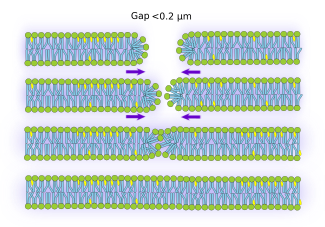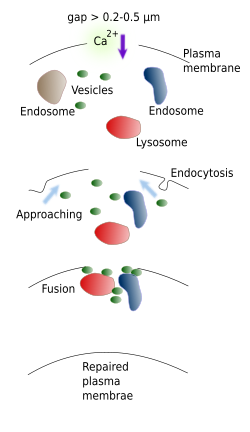1. Asymmetry
- Lipids
- Carbohydrates
- Proteins
2. Fusion
3. Repairing
Asymmetry
Cell membranes are made up of two lipid hemilayers. Lipids, carbohydrates and peripheral proteins are present in different composition when both hemilayers are compared. Moreover, transmembrane proteins are placed in the membrane with a precise orientation. The differential distribution of molecules between both monolayers is referred to as membrane asymmetry.
It is essential for the cell to generate and maintain membrane asymmetry. For example, in the plasma membrane, the outer hemilayer contains most of the lipids having choline, such as phosphatidylcholine and sphingomyelin, whereas the inner hemilayer contains more phosphatidylethanolamine, phosphatidylinositol and phosphatidylserine. The differential distribution of lipids contributes to the membrane electrical potential and facilitates the recruitment of specific proteins to the membrane surfaces. The physical properties of membranes, such as bending, are also influenced by the membrane asymmetry.
The disorganization of membrane asymmetry is usually a signal of something going wrong. For example, during apoptosis (regulated cell death), the outer hemilayer of the plasma membrane exhibits lipids that are typical of the inner monolayer. These lipids are recognized by macrophages that finally remove the cell. The lost of asymmetry in erythrocytes is also important for blood coagulation.
Although membrane asymmetry is largely related to lipid distribution, there is also a differential distribution of carbohydrates and proteins between the two hemilayers of cell membranes. Carbohydrates are mostly present in the outer hemilayer of the plasma membrane, forming the so-called glycocalyx, and in the luminal monolayer of endosomes and lysosomes. Proteins also contribute to membrane asymmetry because they are precisely arranged in membranes. For example, transmembrane proteins in the plasma membrane show a cytosolic domain and an extracellular, or luminal in the organelles, domain.
Where and how is asymmetry generated?
Lipids
The asymmetry of lipids (Figure 1) is mainly generated in the Golgi apparatus. Curiously, in the endoplasmic reticulum, where most lipids are synthesized, there is a very similar distribution between both hemilayers. It is hard for lipids with large polar heads to move from one hemilayer to the other (known as "flip-flop" movement) because of the hydrophobic barrier formed of the fatty acid chains. Lipids with larger polar heads may save this hydrophobic barrier thanks to specific transporters, or translocases, found in membranes. There are three types of translocases: flippases, floppases and scramblases (Figure 2). These proteins move specific lipids between both hemilayers, thus modifying the membrane asymmetry.


Carbohydrates
Carbohydrates are found in the outer hemilayer of the plasma membrane and in the luminal surface of endosomal/lysosomal system. They are synthesized in the endoplasmic reticulum and Golgi apparatus.
Proteins
The rotein location and orientation in membranes is set during their synthesis in the endoplasmic reticulum. However, proteins associated to the cytosolic hemilayer are synthesized in the cytosol by free ribosomes.
2. Fission and fusion
A very useful feature of membranes is their ability to be split and get fused again. It provides an extraordinary plasticity, indispensable for vesicle trafficking, and for cell division, particularly during cytokinesis, where plasma membrane increases in size, breaks, and get sealed again to form the two independent cells.
Repairing
A A number of natural processes and experimental procedures may lead to membrane breakages. Some tissues are under natural mechanical forces that compromise the plasma membrane integrity, as it usually happens in muscular tissue. Holes in the plasma membrane are lethal for the cell if they are not sealed in a few seconds. There are repairing mechanisms to prevent the loss of cellular content and maintain the internal environment different from the external one.
There are two ways to cope with membrane breakages. When the gaps are small (less than 0.2 µm) (Figure 3), the molecular properties of lipids are enough to seal and repair the hole.

When damages are larger (more than 0.2 - 0.5 µm), the edges of the gap are too far from each other and no auto-sealing is possible. Then, a cellular response is initiated (Figure 4). A large gap allows the entering of a huge amount of calcium that changes the cellular behavior. If the calcium concentration is not restored by sealing the breakage, apoptosis is activated and there is loss of cytoplasm. However, the initial increase of calcium triggers the cell repairing mechanisms, which include the fusion of membrane bound compartments located in the cell cortex with the plasma membrane, working like a patch. The compartments involved are endosomes, lysosomes, vesicles and other organelles. Calcium also activates enzymes that help in the sealing process by removing the cytoskeleton of the affected area and making easier the movement of organelles.

Cells and tissues have mechanisms to get adapted to repetitive mechanical stretching, and therefore prevent membranes breakages. Cellular responses to mechanical stress can be studied in cell cultures. It has been observed that stretchings of about 10 to 15 % increase the plasma membrane area by fusion of internal organelles. The cell attachment to the extracellular matrix is also strengthened. The proteins of the cytoskeleton and extracellular matrix increase in number to withstand repetitive mechanical tensions.
Membrane repairing and cellular regeneration are not the same mechanisms. Membrane repairing is started after a membrane damage. Cell regeneration begins when a large part of the cell is lost. Thus, the damaged cell has to synthesize and assemble molecules for the recovering of the cytoplasm and gets the normal state.
-
Bibliography ↷
-
Bibliography
Bittner GD, Spaeth CS, Poon AD, Burgess ZS, McGill CH. 2016. Repair of traumatic plasmalemmal damage to neurons and other eukaryotic cells. Neuronal regeneration research 11:1033-1042.
Daleke DL. 2007. Phospholipid flippases. The journal of biological chemistry. 282:821-825.
McNeil PL, Steinhardt RA. 2003. Plasma membrane disruption: repair, prevention, adaptation. Annual review in cell and development biology. 19:697-731.
Nicolson GL. 2014. The Fluid—Mosaic Model of Membrane Structure: Still relevant to understanding the structure, function and dynamics of biological membranes after more than 40years. Biochimica et Biophysica Acta (BBA)-Biomembranes. 1838(6): 1451-1466.
Quazi F, S. Molday RS. 2011. Lipid transport by mammalian ABC proteins. Essays in biochemistry. 50, 265–290.
Tang SKY, Marshall WF. 2017. Self-repairing cells: How single cells heal membrane ruptures and restore lost structures. Science. 356, 1022-1025.
-
 Permeability, fluidity
Permeability, fluidity